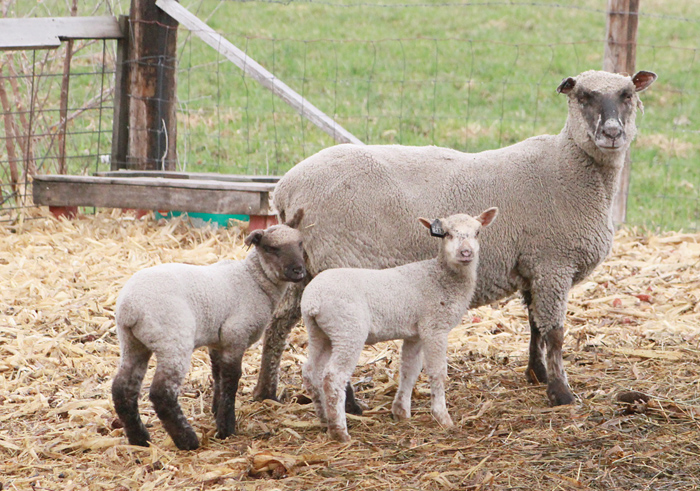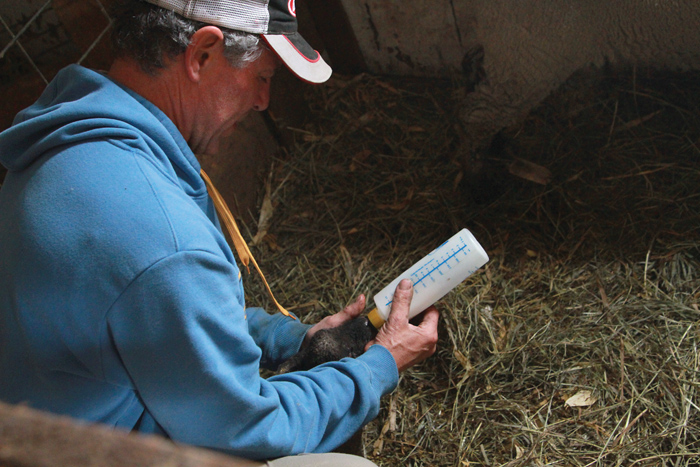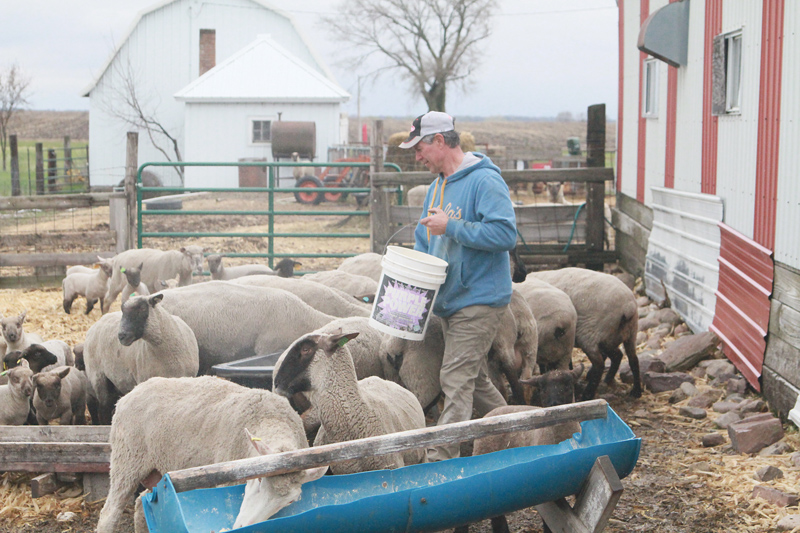This year’s lambing season best yet for Bode

Two lambs stand by their mom at the Bode farm in Courtland.
- Two lambs stand by their mom at the Bode farm in Courtland.
- Henry Bode feeds a three-day old lamb at his farm on April 8.
- Bode feeds his sheep on April 9 at his farm in Courtland.
After moving to Wisconsin in 1985 and returning to Courtland in 2014, Bode was able to accomplish that goal of raising sheep at his farm that’s been in the family since 1907. Bode officially inherited the 23 1/2-acre farm after his mother passed away last May.
Bode, a 1977 Nicollet High School graduate, said that raising sheep was always of interest to him.
“My dad had sheep,” Bode said. “I don’t remember it, but he died when I was young. He had cancer, he was 38 when he died, I was 6, 5. And I saw pictures of him with sheep — he had sheep. He milked cows, raised pigs, had chickens, apparently had some sheep. That was something that I always wanted was to have sheep. I don’t know why, just wanted to. We had cattle, we had hogs after my mom got married again. We farmed the land again, and there was never any building for sheep.
“So when I was in ninth grade at Nicollet, I was in FFA and we had to have an FFA project,” Bode added. “When I came home, I said, ‘I’m having sheep for my FFA project,’ so that kind of forced it. But I had two of them. I raised them, kept the records, and then when I sold them, KNUJ used to report area farmers that sold livestock and what they got, and my two lambs brought USDA choice, top price. So I wanted to continue on with that, and we didn’t have room, so I waited. I waited probably 40, 50 years.”

Henry Bode feeds a three-day old lamb at his farm on April 8.
After his return to Courtland in 2014, Bode started raising sheep in the summer. He started with seven bred ewes.
“Then they were born in ’15, and then I kept some of them and bought a few more and bought a ram,” Bode said. “And now I’m to the point where I’ve got maybe 28 or something like that.”
Bode has three rams at his farm, and they were allowed to breed with the ewes in late September last year. The ewes were split up into three groups so that each ram had an equal number of ewes.
After a five-month gestation period, Bode saw his lambing season begin on Feb. 27.
“Then there was four days with nothing, and then after that it continued regularly with one or two a day, sometimes three a day until I got to the end,” Bode said. “And these last eight were first-time ewes — these were their first lambs.”

Bode feeds his sheep on April 9 at his farm in Courtland.
Bode has his sheep sheared about a month before they lamb, which is done at that time for several reasons.
“The ewe does not insulate herself, she’s not the only one who’s warm,” Bode said. “She can emit heat now and keep the lambs warm. Another reason is maybe they’ll be a little cold, so they’ll go in the barn to have their lamb, they won’t have it outside. So now that the weather’s gotten nice, a few of these have had theirs outside. Another reason you do it then is so that the teats and the udder are available, so the lamb doesn’t go up and start sucking on a hunk of wool. It can find the teats and the udder and can nourish itself.”
Bode’s seventh lambing season has been the best year he’s seen yet, with several twins and triplets being born.
“I’ve had probably six sets of triplets,” Bode said of his 2021 lambing season. “With these ewe lambs that are lambing right now, that’ll change, but I’ve had less singles than I’ve had multiple births. Last year and prior years, I couldn’t say that. And people will ask, ‘Why do you think that is?’ And I just think it’s good hay, good feed, the nutrition. And my pasture is in the woods, so there’s not a terrible amount of grass, but I do rotate it and get them off so the grass can grow and they’re in a different pasture. … Each year I have another pasture that I can rotate more, and it’s probably a combination of all of that.”
For the lambs that Bode decides to sell, he sells them when they get to be about six to seven months old, or 70 pounds. Bode said he’ll normally sell the males and plans to keep about 15 females this year.
There isn’t a contract with anyone when it comes to how many ewes or lambs Bode needs to have, but he said that he’s interested to see how close he can get to having 100 ewes.
“Next year I’m thinking I could have 50 — if I bought a couple, maybe 60 ewes,” Bode said. “I can only lamb about 30 at a time. So if I break that up into two groups, some lamb in March and some lamb in April and May, that’s doable. Just got to see.”
As of April 12, Bode had 54 lambs this season, with 28 ewes giving birth and two to go.
Not baaaaaaad at all.








